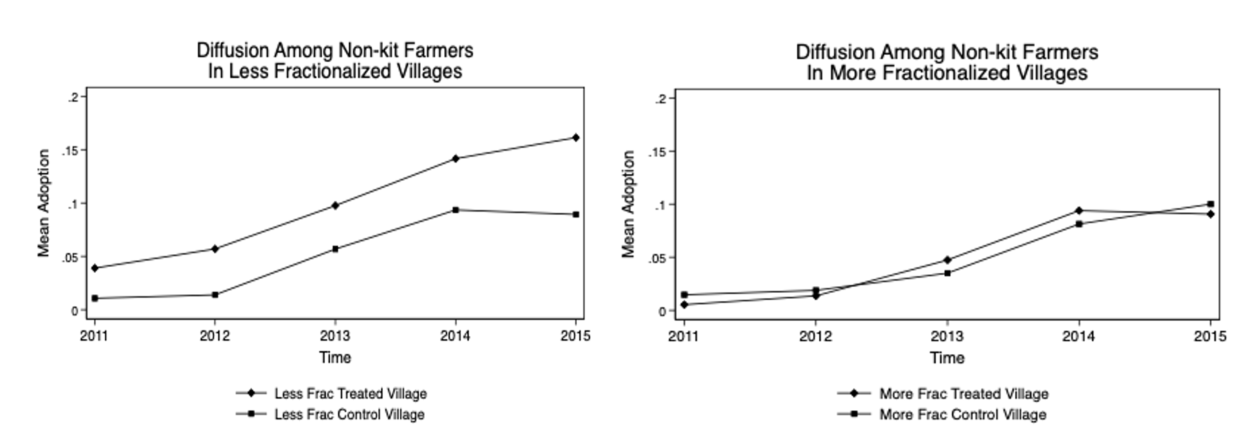
Local social structures, such as the jati-caste system in India, can play an important role in the extent of diffusion of new and beneficial agricultural technologies
Editor's note: This article originally appeared on Ideas for India.
Increasing the adoption rates of beneficial agricultural technologies is an important development policy goal, both to improve agricultural productivity (Gollin et al. 2021) as well as to reduce poverty and achieve sustainable development goals (Foster and Rosenzweig 1996, Bharadwaj et al. 2020). Despite the importance of modern agricultural technologies, the adoption rates follow an S-shaped curve, typically plateauing between 30-40%.1
Social networks, particularly those based on kinship, play an important role in the adoption of new technologies by: (i) addressing informational constraints through social learning when initial recipients talk about their experience within their groups, and (ii) serving as an informal exchange market to access new technologies when recipients share their seeds with their distant cousins and kin. Such mechanisms are particularly important when formal input markets are not well developed, as is the case across rural areas in South Asia and Sub-Saharan Africa.
Jati or caste structures are central to social and economic organisation in India (Munshi and Rosenzweig 2016). The composition of households into different jati groups varies substantially by village, which could affect the extent of technology diffusion. These structures are often related to the initial settlement and rarely change over time (Anderson 2011). As a result, villages in India can be homogenous, with households belonging to relatively few jati groups, or highly fractionalised, with many jatis.
Therefore, understanding how technology diffuses after its initial introduction – in the presence of vast differences in the underlying social structures – is important for research and policy. This helps address concerns about both efficiency (whether the technology reaches those with high marginal benefit) and equity (whether it reaches the marginalised with limited means to learn about and acquire the technology).
Long-run diffusion of flood-resistant paddy variety
In our paper, de Janvry, Rao and Sadoulet (2022), we document the diffusion of a flood-resistant paddy variety (Swarna Sub 1 (SS1)), developed specifically for the growing conditions prevalent in flood-prone coastal regions in eastern India, between 2011 and 2015. Our study sample consists of the same 128 villages drawn from the coastal districts of Balasore and Bhadrak in Odisha as in Emerick et al. (2016), which estimated a large impact of the new variety on agricultural productivity among technology recipients over two main cultivation seasons in 2011 and 2012. Specifically, the variety reduced the downside risk of yield loss from flooding and improved productivity by crowding in complementary investments by the cultivators. We examine subsequent diffusion of the technology among the non-recipient population, over five main cultivation seasons through 2015 after the introduction of the new seed variety in 2011.
We leverage the experimental variation in the dissemination of the SS1 variety at both the village and individual farmer-level to answer our question on the causal role of jati-caste structures in facilitating technology diffusion. Specifically, 64 out of 128 study villages were randomly assigned to be introduced to the seed variety (treated group), and in these villages, five paddy farmers were randomly selected to receive seed mini-kits from the Odisha office of the International Rice Research Institute (IRRI). This is the same experimental design that was set up by the 2016 study. Since the initial village assignment and subsequent seed allocation to individual farmers were both randomised, village-level jati-caste network structure, as well as the extent of jati-based connections between the initial recipient and other non-recipient farmers, are exogenous by design. This variation provides a unique opportunity to study the role of jati-caste structures in technology diffusion, which is otherwise a hard question to answer due to the paucity of exogenous variation in such institutional structures.
Our farmer sample includes 8,500 non-recipient paddy farmers from the original study villages, (that is, those other than the five farmers who initially received SS1 seeds from IRRI). Overall, the diffusion rates of the new variety are modest, at 7% overall, but with 23% higher diffusion in treated villages, four years after the introduction of the variety (de Janvry et al. 2022). We also note that the differences in diffusion in treated villages relative to control are higher among more flood exposed farmers. On the other hand, we note that farmers with lower flood exposure adopt similarly in both treated and control villages.
Differences in diffusion in fractionalised villages
We categorise villages as less or more fractionalised based on two different, correlated measures – the number of distinct jati groups in a village, and based on the Herfindahl Hirschman Index (HHI), using the relative share of population by jati groups.2 In our context, our sample villages span those with only one jati to those with 15 distinct jatis. We use the presence of 6 distinct jatis (or an HHI of 0.6) as the threshold to categorise villages as fractionalised, with villages with values lower than the threshold being categorised as relatively homogenous.
The overall diffusion rates mask substantial heterogeneity based on the underlying village jati-caste networks, even after conditioning on village size. Figure 1 presents the diffusion curves in treated and control villages, separated by whether the underlying jati structure is less or more fractionalised. Two features stand out: (i) a head-start in diffusion in treatment villages relative to control villages among less fractionalised villages, which persist or widens over time , and (ii) there is practically no difference in diffusion between treatment and control groups among fractionalised villages.
Figure 1. Diffusion of seed variety among farmers in less (left panel) and more fractionalised (right panel) villages

Note: The figures plot the average adoption rates in treated and control villages over time, split by the extent of jati-caste fractionalisation in the underlying village social network.
These differences in diffusion could raise concerns about overall welfare and the distributional ramifications due to flood risk. As per Emerick et al. (2016), the technology is particularly beneficial to farmers and villages that are more flood prone, as the flood tolerance attribute of the seed variety increases welfare gains both through the downside risk insurance, as well as from complementary investments in agricultural inputs (which both contribute to increased yields). While we note better diffusion among farmers with higher flood exposure, not all farmers with flood risk are able to adopt.
Diffusion within jati groups
This finding has implications for equity, especially since we find that marginalised jati groups (those belonging to Scheduled Caste or Scheduled Tribe groups) experience higher flood risk in our context. Leveraging farmer-level experimental variation that generates exogenous variation in which jati groups initially received the technology, we note that diffusion is reported when at least one member of the same jati as the non-recipient farmer received seed mini-kits in 2011. The diffusion also happens earlier-on (that is, around the same seasons when the initial recipients start cultivating the new variety). In contrast, diffusion among non-recipient farmers without anyone in their jati as initial recipients follows a similar trajectory as in control villages.
Focusing on the relative differences in jati rank between non-recipients and initial recipients within treated villages, we note that the diffusion is lower if the initial recipients belonged to higher status jati groups. On the other hand, diffusion among non-recipients is no different if the initial recipients were from lower status jatis.
Implication for agricultural technology policies
These findings highlight the fact that local social structures are an important consideration for agricultural technology dissemination policies. While many studies have examined the choice of initial recipients for eventual diffusion (Banerjee et al. 2013, Beaman et al. 2021), we show that even randomised initial dissemination has limitations depending on the underlying caste structure of a village.
In a relatively homogenous society, randomised dissemination has the potential to stimulate diffusion. On the other hand, in a fractionalised society with many distinct groups, it may be effective to draw initial recipients from different groups, particularly those that are marginalised. This is important in a context where markets are poorly developed and there is heavy reliance on farmer-to-farmer exchanges on accessing new technologies.
Note:
- This masks substantial spatial variation, where some districts in northwestern India achieved close to 90% adoption of Green Revolution technologies whereas adoption rates in districts in economically weaker areas in eastern and central India are as low as less than 20% (Bharadwaj et al. 2020). Some of this variation could be explained by differences in crops cultivated and subject to informational constraints (Munshi 2004).
- The Herfindahl Hirschman Index is a measure of market concentration – in this case, when the entire population belongs to the same jati, the village fractionalisation measure yields an HHI of 1. On the other extreme, when the population belongs to many different jati groups, the HHI approaches 0.
References
- Anderson, Siwan (2011), “Caste as an Impediment to Trade”, American Economic Journal: Applied Economics, 3(1): 239-2
- Banerjee, Abhijit, Arun G. Chandrasekhar, Esther Duflo and Matthew O. Jackson (2013), “The Diffusion of Microfinance”, Science, 341(6144):
- Beaman, Lori, Ariel BenYishay, Jeremy Magruder and Ahmed Mushfiq Mobarak (2021), “Can Network Theory-Based Targeting Increase Technology Adoption?”, American Economic Review, 111(6): 1918-19
- Bharadwaj, Prashant, James Fenske, Namrata Kala and Rinchan Ali Mirza (2020), “The Green Revolution and Infant Mortality in India”, Journal of Health Economics, 71(May): 102314.
- Emerick, Kyle, Alain de Janvry, Elisabeth Sadoulet and Manzoor H. Dar (2016), “Technological Innovations, Downside Risk, and the Modernization of Agriculture”, American Economic Review, 106(6): 1537-15
- Foster, Andrew D. and Mark R. Rosenzweig (1996), “Technical Change and Human-Capital Returns and Investments: Evidence from the Green Revolution”, The American Economic Review, 86(4): 931-953.
- Gollin, Douglas, Casper Worm Hansen and Asger Mose Wingender (2021), “Two Blades of Grass: The Impact of the Green Revolution”, Journal of Political Economy, 129(8): 2344-23
- de Janvry, A, M Rao and E Sadoulet (2022), ‘Seeding the Seeds: Role of Social Structure in Agricultural Technology Diffusion’, Working Paper.
- Munshi, Kaivan (2004), “Social Learning in a Heterogeneous Population: Technology Diffusion in the Indian Green Revolution”, Journal of Development Economics, 73(1): 185-213
- Munshi, Kaivan and Mark Rosenzweig (2016), “Networks and Misallocation: Insurance, Migration, and the Rural-Urban Wage Gap”, American Economic Review, 106(1): 46-98.



